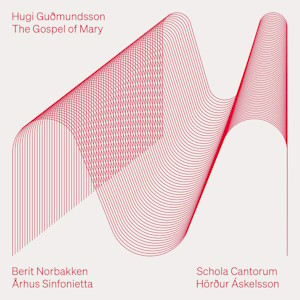
Hugi Guðmundsson (b. 1977)
The Gospel of Mary: an oratorio (2021)
Libretto by Niels Brunse and Nila Parly
Berit Norbakken (soprano)
Schola Cantorum Reykjavicensis
Århus Sinfonietta/Hörður Áskelsson
rec. 2022, Heiligandskirken, Aarhus, Denmark
English text included
Dacapo 8.224736 [62]
Hugi Guðmundsson is Icelandic. As a young man he studied classical and electric guitar and played in rock bands: his preferred kind of music was death metal. He went on to study composition, including electronic and computer music, in Reykjavik and then in Copenhagen, where he continues to live. He has composed a good deal of choral music and, in recent years, concertos and orchestral music. He has written one opera, Hamlet in Absentia.
The Gospel of Mary is based on a fragmentary text from the second century. The Mary in question is Mary Magdalene, but this text could not possibly have been written by her. It is one of a number of texts which were written later than the gospels and other books of the canonical New Testament, attributed to New Testament figures but containing heterodox teachings. They are usually referred to as New Testament Apocrypha. The teaching in this gospel is of a kind called gnostic. Gnosticism was a group of ideas which developed both inside and outside Christianity for some time. There is no single authoritative text, but commonly it suggested that there was a secret tradition outside the church, that the material world was evil and possibly created by a secondary god and that what mattered was not sin and repentance but illumination and enlightenment. Gnosticism was suppressed by the church and many of its books destroyed, but some of them survived and started turning up towards the end of the nineteenth century and have been edited and translated. In this work, Guðmundsson draws on an edition of the gospel by Karen L. King, who sees it as a proto-feminist tract, with Mary explaining the ascent of the soul, having been given knowledge denied to Peter.
I should say that there is nothing particularly novel about composers using non-canonical texts as the basis of choral works. Holst’s Hymn of Jesus, back in the 1920s, uses a text from the apocryphal Acts of St John, and more recently there has been The Gospel according to the Other Mary by John Adams, using texts from various sources – his Mary is Mary of Bethany, not Mary Magdalene.
The work follows the baroque tradition of interweaving gospel texts with meditations, arias and chorales. The meditations are each for a solo woodwind instrument and the arias all for soprano. The choral parts are for a chamber choir. The orchestra is a small one, with single wind and a small string section, along with percussion and an organ. The individual numbers are quite short, but there are nineteen of them and the whole work lasts for just over an hour. The work is set and sung in English.
The numbers are individually quite beautiful. I particularly liked the meditations for solo wind instrument, with the flute one most of all. The solo vocal writing is in an attractive modal idiom and the choral writing almost entirely homophonic. The work is very atmospheric.
However, this is where I have a problem with it. The numbers are individually attractive but they are nearly all slow moving and very similar to one another. There are not the strong contrasts between them which you find, for example, in the Bach Passions. In a work of this length, I found myself craving variety or risking just getting lulled into a trance-like state. However, others may well feel differently, and indeed many do, as this recording has been supported by all sorts of organisations.
The performance is committed and well prepared and Berit Norbakken, the solo soprano, has a lovely voice. The orchestra plays well and the solo instruments all play their meditations expressively. The work has been recorded in an acoustic which allows the sound to expand. The booklet contains explanatory essays in both English and Danish but the text is in English only. There are biographies of the performers but not of the composer – I took his information from his website.
I find it difficult to assess this work. If you like this kind of slow-moving meditative music, you may like it very much indeed. If, like me, you are impatient for more variety, you will not care for it. However, if you do decide to go for it you will be well satisfied with this performance.
Stephen Barber
Help us financially by purchasing from





















